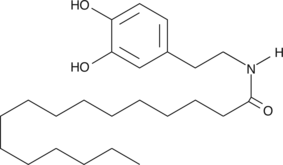Chemicals
Showing 28501–28650 of 41137 results
-
N-Oleoyl leucine is an N-acyl amide generated by PM20D1 that uncouples mitochondrial respiration independent of uncoupling protein 1 (UCP1) in vitro.{31656} N-Oleoyl leucine (25 mg/kg, i.p.) decreases body weight and food intake, preferentially decreasing fat mass in a diet-induced obesity mouse model. It improves glucose homeostasis in a fasting glucose tolerance test and increases VO2 while slightly decreasing overall locomotor activity.
Brand:CaymanSKU:20064 -Available on backorder
N-Oleoyl leucine is an N-acyl amide generated by PM20D1 that uncouples mitochondrial respiration independent of uncoupling protein 1 (UCP1) in vitro.{31656} N-Oleoyl leucine (25 mg/kg, i.p.) decreases body weight and food intake, preferentially decreasing fat mass in a diet-induced obesity mouse model. It improves glucose homeostasis in a fasting glucose tolerance test and increases VO2 while slightly decreasing overall locomotor activity.
Brand:CaymanSKU:20064 -Available on backorder
N-Oleoyl leucine is an N-acyl amide generated by PM20D1 that uncouples mitochondrial respiration independent of uncoupling protein 1 (UCP1) in vitro.{31656} N-Oleoyl leucine (25 mg/kg, i.p.) decreases body weight and food intake, preferentially decreasing fat mass in a diet-induced obesity mouse model. It improves glucose homeostasis in a fasting glucose tolerance test and increases VO2 while slightly decreasing overall locomotor activity.
Brand:CaymanSKU:20064 -Available on backorder
N-Oleoyl proline is an N-acyl amine that has been detected in bovine brain extracts and D. melanogaster larvae using mass spectrometry.{33754,33755} In a preclinical model of pain, mice lacking fatty acid amide hydrolase (FAAH KO) had decreased N-oleoyl proline levels in lumbar spinal cord after capsaicin administration (1 µg/10 µl).{33751} N-Oleoyl proline also has surfactant properties (critical micelle concentration = 4.8 µM).{33753}
Brand:CaymanSKU:20369 -Available on backorder
N-Oleoyl proline is an N-acyl amine that has been detected in bovine brain extracts and D. melanogaster larvae using mass spectrometry.{33754,33755} In a preclinical model of pain, mice lacking fatty acid amide hydrolase (FAAH KO) had decreased N-oleoyl proline levels in lumbar spinal cord after capsaicin administration (1 µg/10 µl).{33751} N-Oleoyl proline also has surfactant properties (critical micelle concentration = 4.8 µM).{33753}
Brand:CaymanSKU:20369 -Available on backorder
N-Oleoyl proline is an N-acyl amine that has been detected in bovine brain extracts and D. melanogaster larvae using mass spectrometry.{33754,33755} In a preclinical model of pain, mice lacking fatty acid amide hydrolase (FAAH KO) had decreased N-oleoyl proline levels in lumbar spinal cord after capsaicin administration (1 µg/10 µl).{33751} N-Oleoyl proline also has surfactant properties (critical micelle concentration = 4.8 µM).{33753}
Brand:CaymanSKU:20369 -Available on backorder
N-Oleoyl proline is an N-acyl amine that has been detected in bovine brain extracts and D. melanogaster larvae using mass spectrometry.{33754,33755} In a preclinical model of pain, mice lacking fatty acid amide hydrolase (FAAH KO) had decreased N-oleoyl proline levels in lumbar spinal cord after capsaicin administration (1 µg/10 µl).{33751} N-Oleoyl proline also has surfactant properties (critical micelle concentration = 4.8 µM).{33753}
Brand:CaymanSKU:20369 -Available on backorder
Several different arachidonoyl amino acids, including N-arachidonoyl dopamine and N-arachidonoyl serine, have been isolated and characterized from bovine brain.{9589} During mass spectral lipidomics analysis of rat brain, a series of fatty acyl amides of a third amino acid, taurine, were discovered.{12336} This novel class of compounds is present in kidney and activates members of the transient receptor potential (TRP) family of calcium channels.{16245} N-Oleoyl taurine is an amino-acyl endocannabinoid isolated from rat brain that may activate TRPV1 and TRPV4.{16245}
Brand:CaymanSKU:10005609 - 1 mgAvailable on backorder
Several different arachidonoyl amino acids, including N-arachidonoyl dopamine and N-arachidonoyl serine, have been isolated and characterized from bovine brain.{9589} During mass spectral lipidomics analysis of rat brain, a series of fatty acyl amides of a third amino acid, taurine, were discovered.{12336} This novel class of compounds is present in kidney and activates members of the transient receptor potential (TRP) family of calcium channels.{16245} N-Oleoyl taurine is an amino-acyl endocannabinoid isolated from rat brain that may activate TRPV1 and TRPV4.{16245}
Brand:CaymanSKU:10005609 - 10 mgAvailable on backorder
Several different arachidonoyl amino acids, including N-arachidonoyl dopamine and N-arachidonoyl serine, have been isolated and characterized from bovine brain.{9589} During mass spectral lipidomics analysis of rat brain, a series of fatty acyl amides of a third amino acid, taurine, were discovered.{12336} This novel class of compounds is present in kidney and activates members of the transient receptor potential (TRP) family of calcium channels.{16245} N-Oleoyl taurine is an amino-acyl endocannabinoid isolated from rat brain that may activate TRPV1 and TRPV4.{16245}
Brand:CaymanSKU:10005609 - 5 mgAvailable on backorder
Several different arachidonoyl amino acids, including N-arachidonoyl dopamine and N-arachidonoyl serine, have been isolated and characterized from bovine brain.{9589} During mass spectral lipidomics analysis of rat brain, a series of fatty acyl amides of a third amino acid, taurine, were discovered.{12336} This novel class of compounds is present in kidney and activates members of the transient receptor potential (TRP) family of calcium channels.{16245} N-Oleoyl taurine is an amino-acyl endocannabinoid isolated from rat brain that may activate TRPV1 and TRPV4.{16245}
Brand:CaymanSKU:10005609 - 500 µgAvailable on backorder
N-Oleoyl valine is an endogenous N-acyl amine that acts as an antagonist at the transient receptor potential vanilloid type 3 (TRPV3) receptor, which is involved in thermoregulation.{34195,34201} N-Oleoyl valine is increased in mice following cold exposure for up to at least 16 days.{31656} Acute lung injury in mice increases the concentration of N-Oleoyl valine in lung tissue.{34194} N-acyl amines also promote mitochondrial uncoupling.{31656}
Brand:CaymanSKU:20065 -Available on backorder
N-Oleoyl valine is an endogenous N-acyl amine that acts as an antagonist at the transient receptor potential vanilloid type 3 (TRPV3) receptor, which is involved in thermoregulation.{34195,34201} N-Oleoyl valine is increased in mice following cold exposure for up to at least 16 days.{31656} Acute lung injury in mice increases the concentration of N-Oleoyl valine in lung tissue.{34194} N-acyl amines also promote mitochondrial uncoupling.{31656}
Brand:CaymanSKU:20065 -Available on backorder
N-Oleoyl valine is an endogenous N-acyl amine that acts as an antagonist at the transient receptor potential vanilloid type 3 (TRPV3) receptor, which is involved in thermoregulation.{34195,34201} N-Oleoyl valine is increased in mice following cold exposure for up to at least 16 days.{31656} Acute lung injury in mice increases the concentration of N-Oleoyl valine in lung tissue.{34194} N-acyl amines also promote mitochondrial uncoupling.{31656}
Brand:CaymanSKU:20065 -Available on backorder
N-Oleoyl valine is an endogenous N-acyl amine that acts as an antagonist at the transient receptor potential vanilloid type 3 (TRPV3) receptor, which is involved in thermoregulation.{34195,34201} N-Oleoyl valine is increased in mice following cold exposure for up to at least 16 days.{31656} Acute lung injury in mice increases the concentration of N-Oleoyl valine in lung tissue.{34194} N-acyl amines also promote mitochondrial uncoupling.{31656}
Brand:CaymanSKU:20065 -Available on backorder
N-Oleoyl-L-phenylalanine is an N-acyl amide.{31656} It increases the oxygen consumption rate (OCR) of mitochondria isolated from mouse brown adipose tissue in a Seahorse assay and decreases oligomycin-induced increases in the mitochondrial membrane potential in C2C12 cells, indicating mitochondrial uncoupling activity, when used at a concentration of 50 µM. N-Oleoyl-L-phenylalanine (30 mg/kg for eight days) reduces food intake and body weight of diet-induced obese mice.
Brand:CaymanSKU:28921 - 1 mgAvailable on backorder
N-Oleoyl-L-phenylalanine is an N-acyl amide.{31656} It increases the oxygen consumption rate (OCR) of mitochondria isolated from mouse brown adipose tissue in a Seahorse assay and decreases oligomycin-induced increases in the mitochondrial membrane potential in C2C12 cells, indicating mitochondrial uncoupling activity, when used at a concentration of 50 µM. N-Oleoyl-L-phenylalanine (30 mg/kg for eight days) reduces food intake and body weight of diet-induced obese mice.
Brand:CaymanSKU:28921 - 10 mgAvailable on backorder
N-Oleoyl-L-phenylalanine is an N-acyl amide.{31656} It increases the oxygen consumption rate (OCR) of mitochondria isolated from mouse brown adipose tissue in a Seahorse assay and decreases oligomycin-induced increases in the mitochondrial membrane potential in C2C12 cells, indicating mitochondrial uncoupling activity, when used at a concentration of 50 µM. N-Oleoyl-L-phenylalanine (30 mg/kg for eight days) reduces food intake and body weight of diet-induced obese mice.
Brand:CaymanSKU:28921 - 5 mgAvailable on backorder
Bone mass and shape is continuously remodeled by the concerted and balanced action of osteoblasts (bone forming cells) and osteoclasts (bone-resorbing cells). The endocannabinoid system plays an essential role in the maintenance of normal bone mass via signaling through the CB2 receptor.{16337} N-Oleoyl-L-serine is an endogenous lipid that has been reported to stimulate bone formation and to inhibit bone resorption.{16395}
Brand:CaymanSKU:13058 - 1 mgAvailable on backorder
Bone mass and shape is continuously remodeled by the concerted and balanced action of osteoblasts (bone forming cells) and osteoclasts (bone-resorbing cells). The endocannabinoid system plays an essential role in the maintenance of normal bone mass via signaling through the CB2 receptor.{16337} N-Oleoyl-L-serine is an endogenous lipid that has been reported to stimulate bone formation and to inhibit bone resorption.{16395}
Brand:CaymanSKU:13058 - 10 mgAvailable on backorder
Bone mass and shape is continuously remodeled by the concerted and balanced action of osteoblasts (bone forming cells) and osteoclasts (bone-resorbing cells). The endocannabinoid system plays an essential role in the maintenance of normal bone mass via signaling through the CB2 receptor.{16337} N-Oleoyl-L-serine is an endogenous lipid that has been reported to stimulate bone formation and to inhibit bone resorption.{16395}
Brand:CaymanSKU:13058 - 5 mgAvailable on backorder
Bone mass and shape is continuously remodeled by the concerted and balanced action of osteoblasts (bone forming cells) and osteoclasts (bone-resorbing cells). The endocannabinoid system plays an essential role in the maintenance of normal bone mass via signaling through the CB2 receptor.{16337} N-Oleoyl-L-serine is an endogenous lipid that has been reported to stimulate bone formation and to inhibit bone resorption.{16395}
Brand:CaymanSKU:13058 - 50 mgAvailable on backorder
The jumonji domain-containing protein 2 (JMJD2) subfamily of histone demethylases have been shown to catalyze demethylation of the methylated forms of histone 3 lysine 9 (H3K9) and H3K36 in vitro and in cells.{19159} Because histone demethylases are implicated in certain diseases, including cancer, selective inhibitors are candidate anticancer agents as well as potential tools for elucidating the biological functions of JMJDs.{18098} N-Oxalylglycine, the amide analog of α-ketoglutarate, is a cell permeable inhibitor of α-ketoglutarate-dependent enzymes, including JMJD2A, JMJD2C, and JMJD2E (IC50s = 250, 500, and 24 μM, respectively).{18003,18511,18060,18061} It can also inhibit the prolyl hydroxylase domain-containing proteins PHD1 and PHD2 with IC50 values of 2.1 and 5.6 μM, respectively.{18511,18060, 18061}
Brand:CaymanSKU:-The jumonji domain-containing protein 2 (JMJD2) subfamily of histone demethylases have been shown to catalyze demethylation of the methylated forms of histone 3 lysine 9 (H3K9) and H3K36 in vitro and in cells.{19159} Because histone demethylases are implicated in certain diseases, including cancer, selective inhibitors are candidate anticancer agents as well as potential tools for elucidating the biological functions of JMJDs.{18098} N-Oxalylglycine, the amide analog of α-ketoglutarate, is a cell permeable inhibitor of α-ketoglutarate-dependent enzymes, including JMJD2A, JMJD2C, and JMJD2E (IC50s = 250, 500, and 24 μM, respectively).{18003,18511,18060,18061} It can also inhibit the prolyl hydroxylase domain-containing proteins PHD1 and PHD2 with IC50 values of 2.1 and 5.6 μM, respectively.{18511,18060, 18061}
Brand:CaymanSKU:-The jumonji domain-containing protein 2 (JMJD2) subfamily of histone demethylases have been shown to catalyze demethylation of the methylated forms of histone 3 lysine 9 (H3K9) and H3K36 in vitro and in cells.{19159} Because histone demethylases are implicated in certain diseases, including cancer, selective inhibitors are candidate anticancer agents as well as potential tools for elucidating the biological functions of JMJDs.{18098} N-Oxalylglycine, the amide analog of α-ketoglutarate, is a cell permeable inhibitor of α-ketoglutarate-dependent enzymes, including JMJD2A, JMJD2C, and JMJD2E (IC50s = 250, 500, and 24 μM, respectively).{18003,18511,18060,18061} It can also inhibit the prolyl hydroxylase domain-containing proteins PHD1 and PHD2 with IC50 values of 2.1 and 5.6 μM, respectively.{18511,18060, 18061}
Brand:CaymanSKU:-The jumonji domain-containing protein 2 (JMJD2) subfamily of histone demethylases have been shown to catalyze demethylation of the methylated forms of histone 3 lysine 9 (H3K9) and H3K36 in vitro and in cells.{19159} Because histone demethylases are implicated in certain diseases, including cancer, selective inhibitors are candidate anticancer agents as well as potential tools for elucidating the biological functions of JMJDs.{18098} N-Oxalylglycine, the amide analog of α-ketoglutarate, is a cell permeable inhibitor of α-ketoglutarate-dependent enzymes, including JMJD2A, JMJD2C, and JMJD2E (IC50s = 250, 500, and 24 μM, respectively).{18003,18511,18060,18061} It can also inhibit the prolyl hydroxylase domain-containing proteins PHD1 and PHD2 with IC50 values of 2.1 and 5.6 μM, respectively.{18511,18060, 18061}
Brand:CaymanSKU:-N-p-Tosyl-Gly-Pro-Lys-pNA is a colorimetric substrate for plasmin.{61063,61064,61065} Plasmin binds and hydrolyzes N-p-tosyl-Gly-Pro-Lys-pNA to release p-nitroanilide (pNA), which can be quantified by colorimetric detection at 405 nm as a measure of plasmin activity.
Brand:CaymanSKU:31544 - 1 mgAvailable on backorder
N-p-Tosyl-Gly-Pro-Lys-pNA is a colorimetric substrate for plasmin.{61063,61064,61065} Plasmin binds and hydrolyzes N-p-tosyl-Gly-Pro-Lys-pNA to release p-nitroanilide (pNA), which can be quantified by colorimetric detection at 405 nm as a measure of plasmin activity.
Brand:CaymanSKU:31544 - 10 mgAvailable on backorder
N-p-Tosyl-Gly-Pro-Lys-pNA is a colorimetric substrate for plasmin.{61063,61064,61065} Plasmin binds and hydrolyzes N-p-tosyl-Gly-Pro-Lys-pNA to release p-nitroanilide (pNA), which can be quantified by colorimetric detection at 405 nm as a measure of plasmin activity.
Brand:CaymanSKU:31544 - 5 mgAvailable on backorder
Several different fatty acyl dopamine analogs, such as N-arachidonoyl dopamine (NADA), N-oleoyl dopamine (ODA) and N-palmitoyl dopamine (PALDA), have been isolated and characterized from bovine brain.{9589,11117} Structurally, PALDA is the amide of palmitic acid and dopamine and is therefore a “hybrid” analog which incorporates components of both the anandamide-like and dopamine neurotransmitter pathways. Unlike NADA and ODA, PALDA is nearly inactive as a vanilloid receptor 1 (VR1) ligand and fails to elicit hyperalgesic or nocifensive responses in vivo.{11117} However, PALDA exhibits an “entourage” effect at concentrations of 0.1-10 µM by potentiating the VR1-mediated effects of NADA and anandamide.{13227}
Brand:CaymanSKU:10007697 - 10 mgAvailable on backorder
Several different fatty acyl dopamine analogs, such as N-arachidonoyl dopamine (NADA), N-oleoyl dopamine (ODA) and N-palmitoyl dopamine (PALDA), have been isolated and characterized from bovine brain.{9589,11117} Structurally, PALDA is the amide of palmitic acid and dopamine and is therefore a “hybrid” analog which incorporates components of both the anandamide-like and dopamine neurotransmitter pathways. Unlike NADA and ODA, PALDA is nearly inactive as a vanilloid receptor 1 (VR1) ligand and fails to elicit hyperalgesic or nocifensive responses in vivo.{11117} However, PALDA exhibits an “entourage” effect at concentrations of 0.1-10 µM by potentiating the VR1-mediated effects of NADA and anandamide.{13227}
Brand:CaymanSKU:10007697 - 100 mgAvailable on backorder
Several different fatty acyl dopamine analogs, such as N-arachidonoyl dopamine (NADA), N-oleoyl dopamine (ODA) and N-palmitoyl dopamine (PALDA), have been isolated and characterized from bovine brain.{9589,11117} Structurally, PALDA is the amide of palmitic acid and dopamine and is therefore a “hybrid” analog which incorporates components of both the anandamide-like and dopamine neurotransmitter pathways. Unlike NADA and ODA, PALDA is nearly inactive as a vanilloid receptor 1 (VR1) ligand and fails to elicit hyperalgesic or nocifensive responses in vivo.{11117} However, PALDA exhibits an “entourage” effect at concentrations of 0.1-10 µM by potentiating the VR1-mediated effects of NADA and anandamide.{13227}
Brand:CaymanSKU:10007697 - 5 mgAvailable on backorder
Several different fatty acyl dopamine analogs, such as N-arachidonoyl dopamine (NADA), N-oleoyl dopamine (ODA) and N-palmitoyl dopamine (PALDA), have been isolated and characterized from bovine brain.{9589,11117} Structurally, PALDA is the amide of palmitic acid and dopamine and is therefore a “hybrid” analog which incorporates components of both the anandamide-like and dopamine neurotransmitter pathways. Unlike NADA and ODA, PALDA is nearly inactive as a vanilloid receptor 1 (VR1) ligand and fails to elicit hyperalgesic or nocifensive responses in vivo.{11117} However, PALDA exhibits an “entourage” effect at concentrations of 0.1-10 µM by potentiating the VR1-mediated effects of NADA and anandamide.{13227}
Brand:CaymanSKU:10007697 - 50 mgAvailable on backorder
The acyl amides are a family of endogenous lipids that act as potent modulators of pain and inflammation. The best characterized members of this family are the arachidonoyl amides, which includes N-arachidonoyl ethanolamide (AEA; anandamide). N-palmitoyl glycine (PalGly) contains an 18-carbon saturated fatty acid that is amide-linked to glycine and is structurally similar to the phospholipid-derived N-acyl ethanolamines. Endogenously produced in rat skin and spinal cord, PalGly is present in 100-fold greater amounts in skin and 3-fold greater in brain compared to AEA.{15693} Injection of 0.43 µg PalGly in rat hindpaw inhibits heat-induced firing of nociceptive neurons in rat dorsal horn.{15693} PalGly treatment induces transient calcium influx in native dorsal root ganglion (DRG) cells and in the PTX-sensitive, DRG-like cell line F-11 (EC50 = 5.5 µM).{15693}
Brand:CaymanSKU:10009020 - 10 mgAvailable on backorder
The acyl amides are a family of endogenous lipids that act as potent modulators of pain and inflammation. The best characterized members of this family are the arachidonoyl amides, which includes N-arachidonoyl ethanolamide (AEA; anandamide). N-palmitoyl glycine (PalGly) contains an 18-carbon saturated fatty acid that is amide-linked to glycine and is structurally similar to the phospholipid-derived N-acyl ethanolamines. Endogenously produced in rat skin and spinal cord, PalGly is present in 100-fold greater amounts in skin and 3-fold greater in brain compared to AEA.{15693} Injection of 0.43 µg PalGly in rat hindpaw inhibits heat-induced firing of nociceptive neurons in rat dorsal horn.{15693} PalGly treatment induces transient calcium influx in native dorsal root ganglion (DRG) cells and in the PTX-sensitive, DRG-like cell line F-11 (EC50 = 5.5 µM).{15693}
Brand:CaymanSKU:10009020 - 100 mgAvailable on backorder
The acyl amides are a family of endogenous lipids that act as potent modulators of pain and inflammation. The best characterized members of this family are the arachidonoyl amides, which includes N-arachidonoyl ethanolamide (AEA; anandamide). N-palmitoyl glycine (PalGly) contains an 18-carbon saturated fatty acid that is amide-linked to glycine and is structurally similar to the phospholipid-derived N-acyl ethanolamines. Endogenously produced in rat skin and spinal cord, PalGly is present in 100-fold greater amounts in skin and 3-fold greater in brain compared to AEA.{15693} Injection of 0.43 µg PalGly in rat hindpaw inhibits heat-induced firing of nociceptive neurons in rat dorsal horn.{15693} PalGly treatment induces transient calcium influx in native dorsal root ganglion (DRG) cells and in the PTX-sensitive, DRG-like cell line F-11 (EC50 = 5.5 µM).{15693}
Brand:CaymanSKU:10009020 - 50 mgAvailable on backorder
The acyl amides are a family of endogenous lipids that act as potent modulators of pain and inflammation. The best characterized members of this family are the arachidonoyl amides, which includes N-arachidonoyl ethanolamide (AEA; anandamide). N-palmitoyl glycine (PalGly) contains an 18-carbon saturated fatty acid that is amide-linked to glycine and is structurally similar to the phospholipid-derived N-acyl ethanolamines. Endogenously produced in rat skin and spinal cord, PalGly is present in 100-fold greater amounts in skin and 3-fold greater in brain compared to AEA.{15693} Injection of 0.43 µg PalGly in rat hindpaw inhibits heat-induced firing of nociceptive neurons in rat dorsal horn.{15693} PalGly treatment induces transient calcium influx in native dorsal root ganglion (DRG) cells and in the PTX-sensitive, DRG-like cell line F-11 (EC50 = 5.5 µM).{15693}
Brand:CaymanSKU:10009020 - 500 mgAvailable on backorder
Several different arachidonoyl amino acids, including N-arachidonoyl dopamine (NADA) and N-arachidonoyl serine (ARA-S), have been isolated and characterized from bovine brain.{9589} During mass spectral lipidomic analysis of rat brain, a series of fatty acyl amides of a third amino acid, taurine, was discovered. N-Palmitoyl taurine is a prominent amino-acyl endocannabinoid isolated from rat brain during lipidomics profiling. Its function is currently under investigation.
Brand:CaymanSKU:10005611 - 1 mgAvailable on backorder
Several different arachidonoyl amino acids, including N-arachidonoyl dopamine (NADA) and N-arachidonoyl serine (ARA-S), have been isolated and characterized from bovine brain.{9589} During mass spectral lipidomic analysis of rat brain, a series of fatty acyl amides of a third amino acid, taurine, was discovered. N-Palmitoyl taurine is a prominent amino-acyl endocannabinoid isolated from rat brain during lipidomics profiling. Its function is currently under investigation.
Brand:CaymanSKU:10005611 - 10 mgAvailable on backorder
Several different arachidonoyl amino acids, including N-arachidonoyl dopamine (NADA) and N-arachidonoyl serine (ARA-S), have been isolated and characterized from bovine brain.{9589} During mass spectral lipidomic analysis of rat brain, a series of fatty acyl amides of a third amino acid, taurine, was discovered. N-Palmitoyl taurine is a prominent amino-acyl endocannabinoid isolated from rat brain during lipidomics profiling. Its function is currently under investigation.
Brand:CaymanSKU:10005611 - 5 mgAvailable on backorder
N-Palmitoyl-L-aspartate is a natural N-acylaspartate that inhibits Hedgehog signaling after stimulation with Smoothened agonist (SAG; Item No. 11914) or non-sterol-modified Sonic Hedgehog.{31541} It does not alter the activity of cannabinoid receptors or fatty acid amide hydrolase.{31541}
Brand:CaymanSKU:19952 -Available on backorder
N-Palmitoyl-L-aspartate is a natural N-acylaspartate that inhibits Hedgehog signaling after stimulation with Smoothened agonist (SAG; Item No. 11914) or non-sterol-modified Sonic Hedgehog.{31541} It does not alter the activity of cannabinoid receptors or fatty acid amide hydrolase.{31541}
Brand:CaymanSKU:19952 -Available on backorder
N-Palmitoyl-L-aspartate is a natural N-acylaspartate that inhibits Hedgehog signaling after stimulation with Smoothened agonist (SAG; Item No. 11914) or non-sterol-modified Sonic Hedgehog.{31541} It does not alter the activity of cannabinoid receptors or fatty acid amide hydrolase.{31541}
Brand:CaymanSKU:19952 -Available on backorder
N-Palmitoyl-L-aspartate is a natural N-acylaspartate that inhibits Hedgehog signaling after stimulation with Smoothened agonist (SAG; Item No. 11914) or non-sterol-modified Sonic Hedgehog.{31541} It does not alter the activity of cannabinoid receptors or fatty acid amide hydrolase.{31541}
Brand:CaymanSKU:19952 -Available on backorder
Quorum sensing is a regulatory system used by bacteria for controlling gene expression in response to increasing cell density.{15370} This regulatory process manifests itself with a variety of phenotypes including biofilm formation and virulence factor production.{13434} Coordinated gene expression is achieved by the production, release, and detection of small diffusible signal molecules called autoinducers. The N-acylated homoserine lactones (AHLs) comprise one such class of autoinducers, each of which generally consists of a fatty acid coupled with homoserine lactone (HSL). Regulation of bacterial quorum sensing signaling systems to inhibit pathogenesis represents a new approach to antimicrobial therapy in the treatment of infectious diseases.{15369} AHLs vary in acyl group length (C4-C18), in the substitution of C3 (hydrogen, hydroxyl, or oxo group), and in the presence or absence of one or more carbon-carbon double bonds in the fatty acid chain. These differences confer signal specificity through the affinity of transcriptional regulators of the LuxR family.{15398} C15-HSL is a product of Y. pseudituberculosis.{15932}
Brand:CaymanSKU:-Quorum sensing is a regulatory system used by bacteria for controlling gene expression in response to increasing cell density.{15370} This regulatory process manifests itself with a variety of phenotypes including biofilm formation and virulence factor production.{13434} Coordinated gene expression is achieved by the production, release, and detection of small diffusible signal molecules called autoinducers. The N-acylated homoserine lactones (AHLs) comprise one such class of autoinducers, each of which generally consists of a fatty acid coupled with homoserine lactone (HSL). Regulation of bacterial quorum sensing signaling systems to inhibit pathogenesis represents a new approach to antimicrobial therapy in the treatment of infectious diseases.{15369} AHLs vary in acyl group length (C4-C18), in the substitution of C3 (hydrogen, hydroxyl, or oxo group), and in the presence or absence of one or more carbon-carbon double bonds in the fatty acid chain. These differences confer signal specificity through the affinity of transcriptional regulators of the LuxR family.{15398} C15-HSL is a product of Y. pseudituberculosis.{15932}
Brand:CaymanSKU:-Quorum sensing is a regulatory system used by bacteria for controlling gene expression in response to increasing cell density.{15370} This regulatory process manifests itself with a variety of phenotypes including biofilm formation and virulence factor production.{13434} Coordinated gene expression is achieved by the production, release, and detection of small diffusible signal molecules called autoinducers. The N-acylated homoserine lactones (AHLs) comprise one such class of autoinducers, each of which generally consists of a fatty acid coupled with homoserine lactone (HSL). Regulation of bacterial quorum sensing signaling systems to inhibit pathogenesis represents a new approach to antimicrobial therapy in the treatment of infectious diseases.{15369} AHLs vary in acyl group length (C4-C18), in the substitution of C3 (hydrogen, hydroxyl, or oxo group), and in the presence or absence of one or more carbon-carbon double bonds in the fatty acid chain. These differences confer signal specificity through the affinity of transcriptional regulators of the LuxR family.{15398} C15-HSL is a product of Y. pseudituberculosis.{15932}
Brand:CaymanSKU:-Quorum sensing is a regulatory system used by bacteria for controlling gene expression in response to increasing cell density.{15370} This regulatory process manifests itself with a variety of phenotypes including biofilm formation and virulence factor production.{13434} Coordinated gene expression is achieved by the production, release, and detection of small diffusible signal molecules called autoinducers. The N-acylated homoserine lactones (AHLs) comprise one such class of autoinducers, each of which generally consists of a fatty acid coupled with homoserine lactone (HSL). Regulation of bacterial quorum sensing signaling systems to inhibit pathogenesis represents a new approach to antimicrobial therapy in the treatment of infectious diseases.{15369} AHLs vary in acyl group length (C4-C18), in the substitution of C3 (hydrogen, hydroxyl, or oxo group), and in the presence or absence of one or more carbon-carbon double bonds in the fatty acid chain. These differences confer signal specificity through the affinity of transcriptional regulators of the LuxR family.{15398} C15-HSL is a product of Y. pseudituberculosis.{15932}
Brand:CaymanSKU:-Quorum sensing is a regulatory system used by bacteria for controlling gene expression in response to increasing cell density.{15370} This regulatory process manifests itself with a variety of phenotypes including biofilm formation and virulence factor production.{13434} Coordinated gene expression is achieved by the production, release, and detection of small diffusible signal molecules called autoinducers. Autoinducers containing a phenylacetanoyl group in the acyl chain display a wide range of inhibitory and activating effects on various R protein transcriptional regulators.{26043,26044,15550} N-phenylacetyl-L-Homoserine lactone is a small diffusible signaling molecule involved in quorum sensing in the model symbiont V. fischeri and the pathogens A. tumefaciens and P. aeruginosa.{15550,26045} It has been reported to antagonize TraR signaling in A. tumefaciens, LasR signaling in E. coli, and LuxR signaling in V. fischeri.{26044}
Brand:CaymanSKU:9001737 - 1 mgAvailable on backorder
Quorum sensing is a regulatory system used by bacteria for controlling gene expression in response to increasing cell density.{15370} This regulatory process manifests itself with a variety of phenotypes including biofilm formation and virulence factor production.{13434} Coordinated gene expression is achieved by the production, release, and detection of small diffusible signal molecules called autoinducers. Autoinducers containing a phenylacetanoyl group in the acyl chain display a wide range of inhibitory and activating effects on various R protein transcriptional regulators.{26043,26044,15550} N-phenylacetyl-L-Homoserine lactone is a small diffusible signaling molecule involved in quorum sensing in the model symbiont V. fischeri and the pathogens A. tumefaciens and P. aeruginosa.{15550,26045} It has been reported to antagonize TraR signaling in A. tumefaciens, LasR signaling in E. coli, and LuxR signaling in V. fischeri.{26044}
Brand:CaymanSKU:9001737 - 10 mgAvailable on backorder
Quorum sensing is a regulatory system used by bacteria for controlling gene expression in response to increasing cell density.{15370} This regulatory process manifests itself with a variety of phenotypes including biofilm formation and virulence factor production.{13434} Coordinated gene expression is achieved by the production, release, and detection of small diffusible signal molecules called autoinducers. Autoinducers containing a phenylacetanoyl group in the acyl chain display a wide range of inhibitory and activating effects on various R protein transcriptional regulators.{26043,26044,15550} N-phenylacetyl-L-Homoserine lactone is a small diffusible signaling molecule involved in quorum sensing in the model symbiont V. fischeri and the pathogens A. tumefaciens and P. aeruginosa.{15550,26045} It has been reported to antagonize TraR signaling in A. tumefaciens, LasR signaling in E. coli, and LuxR signaling in V. fischeri.{26044}
Brand:CaymanSKU:9001737 - 25 mgAvailable on backorder
Quorum sensing is a regulatory system used by bacteria for controlling gene expression in response to increasing cell density.{15370} This regulatory process manifests itself with a variety of phenotypes including biofilm formation and virulence factor production.{13434} Coordinated gene expression is achieved by the production, release, and detection of small diffusible signal molecules called autoinducers. Autoinducers containing a phenylacetanoyl group in the acyl chain display a wide range of inhibitory and activating effects on various R protein transcriptional regulators.{26043,26044,15550} N-phenylacetyl-L-Homoserine lactone is a small diffusible signaling molecule involved in quorum sensing in the model symbiont V. fischeri and the pathogens A. tumefaciens and P. aeruginosa.{15550,26045} It has been reported to antagonize TraR signaling in A. tumefaciens, LasR signaling in E. coli, and LuxR signaling in V. fischeri.{26044}
Brand:CaymanSKU:9001737 - 5 mgAvailable on backorder
N-Phenylacetyl-L-prolylglycine ethyl ester is a synthetic dipeptide that has been shown to produce positive nootropic and cognitive effects in animal models (0.01-0.8 mg/kg) by a mechanism similar to other related racetam compounds.{24753} It can rescue neuroblastoma SH-SY5Y cells from amyloid-induced cytotoxicity, indicating a potential application in the treatment of neurodegenerative diseases.{24754} It also demonstrates antioxidant and anti-inflammatory effects, which have been examined in the context of an anti-diabetic agent.{24755} This compound was recently identified in illegal designer herbal products distributed in Japan and is intended for research and forensic purposes only.{23615}
Brand:CaymanSKU:-N-Phenylacetyl-L-prolylglycine ethyl ester is a synthetic dipeptide that has been shown to produce positive nootropic and cognitive effects in animal models (0.01-0.8 mg/kg) by a mechanism similar to other related racetam compounds.{24753} It can rescue neuroblastoma SH-SY5Y cells from amyloid-induced cytotoxicity, indicating a potential application in the treatment of neurodegenerative diseases.{24754} It also demonstrates antioxidant and anti-inflammatory effects, which have been examined in the context of an anti-diabetic agent.{24755} This compound was recently identified in illegal designer herbal products distributed in Japan and is intended for research and forensic purposes only.{23615}
Brand:CaymanSKU:-N-Phenylacetyl-L-prolylglycine ethyl ester is a synthetic dipeptide that has been shown to produce positive nootropic and cognitive effects in animal models (0.01-0.8 mg/kg) by a mechanism similar to other related racetam compounds.{24753} It can rescue neuroblastoma SH-SY5Y cells from amyloid-induced cytotoxicity, indicating a potential application in the treatment of neurodegenerative diseases.{24754} It also demonstrates antioxidant and anti-inflammatory effects, which have been examined in the context of an anti-diabetic agent.{24755} This compound was recently identified in illegal designer herbal products distributed in Japan and is intended for research and forensic purposes only.{23615}
Brand:CaymanSKU:-N-Phenylpiperidin-4-amine is a building block.{56192} It has been used in the synthesis of M. tuberculosis decaprenylphosphoryl-β-D-ribose 2′-epimerase (DprE1) inhibitors.
Brand:CaymanSKU:30898 - 1 mgAvailable on backorder
N-Phenylpiperidin-4-amine is a building block.{56192} It has been used in the synthesis of M. tuberculosis decaprenylphosphoryl-β-D-ribose 2′-epimerase (DprE1) inhibitors.
Brand:CaymanSKU:30898 - 10 mgAvailable on backorder
N-Phenylpiperidin-4-amine is a building block.{56192} It has been used in the synthesis of M. tuberculosis decaprenylphosphoryl-β-D-ribose 2′-epimerase (DprE1) inhibitors.
Brand:CaymanSKU:30898 - 5 mgAvailable on backorder
N-Phenylthiourea is a tyrosinase inhibitor (Ki = 0.21 μM in an enzyme assay using L-DOPA as a substrate) and building block.{52758,52759} It increases the susceptibility of SK-MEL-188 melanoma cells in melanogenesis-inducing conditions to γ-radiation-induced cytotoxicity when used at a concentration of 0.01 μM.{52760} N-Phenylthiourea has been used as a precursor in the synthesis of compounds with antibacterial and antifungal activities.{52759} It has also been used as a genetic marker for taste because only some people detect it as a bitter taste.{22286}
Brand:CaymanSKU:30855 - 100 gAvailable on backorder
N-Phenylthiourea is a tyrosinase inhibitor (Ki = 0.21 μM in an enzyme assay using L-DOPA as a substrate) and building block.{52758,52759} It increases the susceptibility of SK-MEL-188 melanoma cells in melanogenesis-inducing conditions to γ-radiation-induced cytotoxicity when used at a concentration of 0.01 μM.{52760} N-Phenylthiourea has been used as a precursor in the synthesis of compounds with antibacterial and antifungal activities.{52759} It has also been used as a genetic marker for taste because only some people detect it as a bitter taste.{22286}
Brand:CaymanSKU:30855 - 25 gAvailable on backorder
N-Phenylthiourea is a tyrosinase inhibitor (Ki = 0.21 μM in an enzyme assay using L-DOPA as a substrate) and building block.{52758,52759} It increases the susceptibility of SK-MEL-188 melanoma cells in melanogenesis-inducing conditions to γ-radiation-induced cytotoxicity when used at a concentration of 0.01 μM.{52760} N-Phenylthiourea has been used as a precursor in the synthesis of compounds with antibacterial and antifungal activities.{52759} It has also been used as a genetic marker for taste because only some people detect it as a bitter taste.{22286}
Brand:CaymanSKU:30855 - 250 gAvailable on backorder
N-Phenylthiourea is a tyrosinase inhibitor (Ki = 0.21 μM in an enzyme assay using L-DOPA as a substrate) and building block.{52758,52759} It increases the susceptibility of SK-MEL-188 melanoma cells in melanogenesis-inducing conditions to γ-radiation-induced cytotoxicity when used at a concentration of 0.01 μM.{52760} N-Phenylthiourea has been used as a precursor in the synthesis of compounds with antibacterial and antifungal activities.{52759} It has also been used as a genetic marker for taste because only some people detect it as a bitter taste.{22286}
Brand:CaymanSKU:30855 - 50 gAvailable on backorder
Brand:CaymanSKU:10007092 - 1 gAvailable on backorder
Brand:CaymanSKU:10007092 - 10 gAvailable on backorder
Brand:CaymanSKU:10007092 - 5 gAvailable on backorder
Brand:CaymanSKU:10007092 - 500 mgAvailable on backorder
N-propyl Hexylone (hydrochloride) (Item No. 27078) is an analytical reference standard categorized as a cathinone. This product is intended for research and forensic applications.
Brand:CaymanSKU:27078 - 1 mgAvailable on backorder
N-propyl Hexylone (hydrochloride) (Item No. 27078) is an analytical reference standard categorized as a cathinone. This product is intended for research and forensic applications.
Brand:CaymanSKU:27078 - 5 mgAvailable on backorder
N-Propylamphetamine is an N-substituted amphetamine with a propyl group on the amphetamine backbone. It has about one-fourth the potency of N-ethylamphetamine (Item No. 11557) in impairing the performance of rats in various tests.{26035} The toxicological properties of this compound are not known. This product is intended for forensic and research applications.
Brand:CaymanSKU:-N-Propylamphetamine is an N-substituted amphetamine with a propyl group on the amphetamine backbone. It has about one-fourth the potency of N-ethylamphetamine (Item No. 11557) in impairing the performance of rats in various tests.{26035} The toxicological properties of this compound are not known. This product is intended for forensic and research applications.
Brand:CaymanSKU:-N-Propylamphetamine is an N-substituted amphetamine with a propyl group on the amphetamine backbone. It has about one-fourth the potency of N-ethylamphetamine (Item No. 11557) in impairing the performance of rats in various tests.{26035} The toxicological properties of this compound are not known. This product is intended for forensic and research applications.
Brand:CaymanSKU:-Several different arachidonoyl amino acids, including N-arachidonoyl dopamine (NADA) and N-arachidonoyl serine (ARA-S), have been isolated and characterized from bovine brain.{9589} During mass spectral lipidomic analysis of rat brain, a series of fatty acyl amides of a third amino acid, taurine, was discovered.{12484} This novel class of compounds is present in kidney and activates members of the transient receptor potential (TRP) family of calcium channels.{16245} N-Stearoyl taurine is a prominent amino-acyl endocannabinoid isolated from rat brain during lipidomics profiling.{16245}
Brand:CaymanSKU:10005610 - 1 mgAvailable on backorder
Several different arachidonoyl amino acids, including N-arachidonoyl dopamine (NADA) and N-arachidonoyl serine (ARA-S), have been isolated and characterized from bovine brain.{9589} During mass spectral lipidomic analysis of rat brain, a series of fatty acyl amides of a third amino acid, taurine, was discovered.{12484} This novel class of compounds is present in kidney and activates members of the transient receptor potential (TRP) family of calcium channels.{16245} N-Stearoyl taurine is a prominent amino-acyl endocannabinoid isolated from rat brain during lipidomics profiling.{16245}
Brand:CaymanSKU:10005610 - 10 mgAvailable on backorder
Several different arachidonoyl amino acids, including N-arachidonoyl dopamine (NADA) and N-arachidonoyl serine (ARA-S), have been isolated and characterized from bovine brain.{9589} During mass spectral lipidomic analysis of rat brain, a series of fatty acyl amides of a third amino acid, taurine, was discovered.{12484} This novel class of compounds is present in kidney and activates members of the transient receptor potential (TRP) family of calcium channels.{16245} N-Stearoyl taurine is a prominent amino-acyl endocannabinoid isolated from rat brain during lipidomics profiling.{16245}
Brand:CaymanSKU:10005610 - 5 mgAvailable on backorder
N-tert-butyl-α-Phenylnitrone (PBN) is a cell permeable spin trap commonly used in free radical research.{9996} It protects against oxidative damage caused by various inflammatory events, demonstrating neuroprotective, anti-anging, and antidiabetic effects.{9453} At millimolar concentrations, PBN has been shown to inhibit LPS-induced NF-κB DNA binding activity and inhibits COX-2 catalytic activity.{7405}
Brand:CaymanSKU:-N-tert-butyl-α-Phenylnitrone (PBN) is a cell permeable spin trap commonly used in free radical research.{9996} It protects against oxidative damage caused by various inflammatory events, demonstrating neuroprotective, anti-anging, and antidiabetic effects.{9453} At millimolar concentrations, PBN has been shown to inhibit LPS-induced NF-κB DNA binding activity and inhibits COX-2 catalytic activity.{7405}
Brand:CaymanSKU:-Quorum sensing is a regulatory system used by bacteria for controlling gene expression in response to increasing cell density. Controlling bacterial infections by quenching their quorum sensing systems is a promising field of study. The expression of specific target genes, such as transcriptional regulators belonging to the LuxR family of proteins, is coordinated by the synthesis of diffusible acylhomoserine lactone (AHL) molecules. N-tetradecanoyl-L-Homoserine lactone (C14-HSL) is a small diffusible signaling molecule involved in quorum sensing, thereby controlling gene expression and affecting cellular metabolism in bacteria.{16305,16307,16308} It appears later than shorter acyl chain AHLs in developing biofilms{16592} and, like other long chain AHLs, stimulates bacterial growth.{16595} C14-HSL also alters the proteolytic activity and enhances the migration of some strains of Proteus mirabilis.{16596}
Brand:CaymanSKU:10011200 - 10 mgAvailable on backorder
Quorum sensing is a regulatory system used by bacteria for controlling gene expression in response to increasing cell density. Controlling bacterial infections by quenching their quorum sensing systems is a promising field of study. The expression of specific target genes, such as transcriptional regulators belonging to the LuxR family of proteins, is coordinated by the synthesis of diffusible acylhomoserine lactone (AHL) molecules. N-tetradecanoyl-L-Homoserine lactone (C14-HSL) is a small diffusible signaling molecule involved in quorum sensing, thereby controlling gene expression and affecting cellular metabolism in bacteria.{16305,16307,16308} It appears later than shorter acyl chain AHLs in developing biofilms{16592} and, like other long chain AHLs, stimulates bacterial growth.{16595} C14-HSL also alters the proteolytic activity and enhances the migration of some strains of Proteus mirabilis.{16596}
Brand:CaymanSKU:10011200 - 25 mgAvailable on backorder
Quorum sensing is a regulatory system used by bacteria for controlling gene expression in response to increasing cell density. Controlling bacterial infections by quenching their quorum sensing systems is a promising field of study. The expression of specific target genes, such as transcriptional regulators belonging to the LuxR family of proteins, is coordinated by the synthesis of diffusible acylhomoserine lactone (AHL) molecules. N-tetradecanoyl-L-Homoserine lactone (C14-HSL) is a small diffusible signaling molecule involved in quorum sensing, thereby controlling gene expression and affecting cellular metabolism in bacteria.{16305,16307,16308} It appears later than shorter acyl chain AHLs in developing biofilms{16592} and, like other long chain AHLs, stimulates bacterial growth.{16595} C14-HSL also alters the proteolytic activity and enhances the migration of some strains of Proteus mirabilis.{16596}
Brand:CaymanSKU:10011200 - 5 mgAvailable on backorder
Quorum sensing is a regulatory system used by bacteria for controlling gene expression in response to increasing cell density. Controlling bacterial infections by quenching their quorum sensing systems is a promising field of study. The expression of specific target genes, such as transcriptional regulators belonging to the LuxR family of proteins, is coordinated by the synthesis of diffusible acylhomoserine lactone (AHL) molecules. N-tetradecanoyl-L-Homoserine lactone (C14-HSL) is a small diffusible signaling molecule involved in quorum sensing, thereby controlling gene expression and affecting cellular metabolism in bacteria.{16305,16307,16308} It appears later than shorter acyl chain AHLs in developing biofilms{16592} and, like other long chain AHLs, stimulates bacterial growth.{16595} C14-HSL also alters the proteolytic activity and enhances the migration of some strains of Proteus mirabilis.{16596}
Brand:CaymanSKU:10011200 - 50 mgAvailable on backorder
N-trans-Feruloyltyramine is a phenolic amide originally isolated from S. melongena that has diverse biological activities, including anti-inflammatory, antioxidative, and antiproliferative properties.{45249} It decreases nitric oxide (NO) production (IC50 = 17.36 µM) and inducible NO synthase (iNOS) activity and increases NO scavenging without inducing cytotoxicity in LPS-stimulated BV-2 cells.{45250} It also scavenges 2,2-diphenyl-1-picrylhydrazyl (DPPH; Item No. 14805) radicals in TLC autographic and spectrophotometric assays.{45251} N-trans-Feruloyltyramine inhibits proliferation of HeLa and L929 cells by 72.2 and 22%, respectively, when used at a concentration of 30 µg/ml.{45252}
Brand:CaymanSKU:27459 - 1 mgAvailable on backorder























